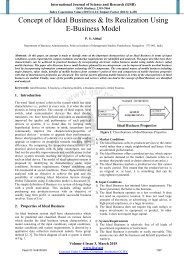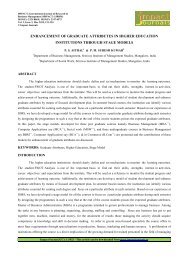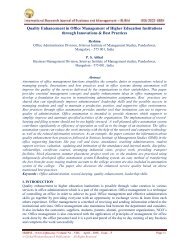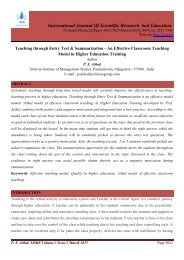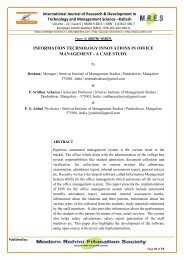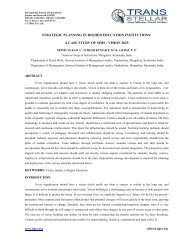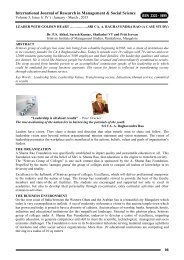How Innovations and Best Practices can Transform Higher Education Institutions : A case study of SIMS
Education has become competitive so as the educational institutions. In order to survive the competition, institutions have to improve the quality of their services. Changes in culture, aspiration and levels of skills required in securing employment for students, force higher education institutions today to rework on their educational models and add value to each and every aspect of their service. Innovations and best practices serve to enhance quality and add value. Srinivas Institute of Management Studies (SIMS), which combines technology, management and social service education has identified and implemented innovations and best practices to differentiate itself among the competitors and to add value in its educational services. In this paper, we have discussed innovations, small and big, develped indigineously and implemented during last four years. They are broadly classified under six key aspects namely "curricular aspects, teaching-learning and evaluation, research, consultancy and extension, infrastructure and learning resources, student support and progression, and governance, leadership, and management". The paper also contains some of the intitutional and individual faculty best practices having visible impact on the quality of higher education imparted by the institution. The best practices concern admission, fees, attendance, teaching, performance, skill building, employability, student involvement, collective learning, value addition, ensuring transparency, information dessimination etc. Finally two institutional best practices are elaborated with its aim of practice, underlying principles and concepts, particular contextual features or challenging issues that have had to be addressed in designing and implementing the practice, and its implementation, including its uniqueness in Indian higher education, evidence of success, identifying the problems encountered and resources required to implement the practice.
Education has become competitive so as the educational institutions. In order to survive the competition, institutions have to improve the quality of their services. Changes in culture, aspiration
and levels of skills required in securing employment for students, force higher education institutions
today to rework on their educational models and add value to each and every aspect of their service. Innovations and best practices serve to enhance quality and add value. Srinivas Institute of
Management Studies (SIMS), which combines technology, management and social service education
has identified and implemented innovations and best practices to differentiate itself among the competitors and to add value in its educational services. In this paper, we have discussed
innovations, small and big, develped indigineously and implemented during last four years. They are
broadly classified under six key aspects namely "curricular aspects, teaching-learning and evaluation, research, consultancy and extension, infrastructure and learning resources, student support and progression, and governance, leadership, and management". The paper also contains some of the
intitutional and individual faculty best practices having visible impact on the quality of higher education imparted by the institution. The best practices concern admission, fees, attendance, teaching, performance, skill building, employability, student involvement, collective learning, value
addition, ensuring transparency, information dessimination etc. Finally two institutional best practices are elaborated with its aim of practice, underlying principles and concepts, particular contextual features or challenging issues that have had to be addressed in designing and implementing the practice, and its implementation, including its uniqueness in Indian higher
education, evidence of success, identifying the problems encountered and resources required to implement the practice.
Create successful ePaper yourself
Turn your PDF publications into a flip-book with our unique Google optimized e-Paper software.
International Journal <strong>of</strong> Management (IJM), ISSN 0976 – 6502(Print), ISSN 0976 - 6510(Online),<br />
Volume 6, Issue 2, February (2015), pp. 83-98 © IAEME<br />
4. Oral story telling (OST)<br />
We have a pr<strong>of</strong>ound need to tell <strong>and</strong> hear stories. It is how we share experience, underst<strong>and</strong><br />
each other, <strong>and</strong> create continuity. Every conversation is full <strong>of</strong> personal anecdote; every effort to<br />
explain shared customs <strong>and</strong> values need a tale; every bit <strong>of</strong> wisdom is best expressed by a story. The<br />
very way our minds think is in essence a story. Picturising ideas in the form <strong>of</strong> story helps retain it<br />
in memory.<br />
[Faculty 4]<br />
5. Milly (Most Important Lesson Learnt Yesterday)<br />
This practice is being followed to achieve the goal <strong>of</strong> keeping the students continuously in<br />
touch with the subject. This is practiced by way <strong>of</strong> discussing with the students what they consider<br />
as most important learning in the last class. This gets best result if the participating students are<br />
given extra marks in their internal assessment. To ensure that there are no doubts, the discussion that<br />
is done in the class towards the end to clear their doubts.<br />
[Faculty 5]<br />
6. Z to A approach<br />
Z to A approach is working backwards. It attempts to explain application first <strong>and</strong> then the<br />
concept. Personalized reflection about an experience <strong>and</strong> applying learning to arrive at the concept is<br />
the core <strong>of</strong> this best practice.<br />
[Faculty 6]<br />
7. TBX- (Team building exercises- From competition to collaboration)<br />
The goals <strong>of</strong> this way <strong>of</strong> learning is to build better motivated students, bringing in creativity<br />
in class room, <strong>and</strong> better problem solving skills. In this process, emphasis on team building through<br />
activities, whether they are five-minute games or week-long assignments, to teach essential<br />
collaborative skills while helping students develop trust in each other <strong>and</strong> each other's abilities.<br />
Students are able to share their outcomes with others - resulting in pride in their accomplishments<br />
<strong>and</strong> reinforcing that learning is a constructive process rather than merely a process <strong>of</strong> fact retention.<br />
[Faculty 7]<br />
8. Exploding the Syllabus for topic based assignments<br />
The Lecturer has to explode the syllabus <strong>of</strong> the subject which he teaches, to smaller topics.<br />
Each <strong>of</strong> these topics <strong>can</strong> be given to the students as Assignment to cover all the aspects related to the<br />
topic, which becomes a knowledge-bank on that subject.<br />
[Faculty 8]<br />
9. Business practice simulation<br />
Virtual trading is a practice used for teaching finance management to students to show how<br />
online platforms <strong>can</strong> be used to replicate the real market scenarios so as to make the students aware<br />
<strong>of</strong> the nuances <strong>of</strong> Stock Market. Through interactive sessions using online platform <strong>and</strong> live market<br />
on display, students are made to learn the trading <strong>and</strong> investment in stock market by means <strong>of</strong> virtual<br />
trading. This practice requires continuous attention <strong>of</strong> students <strong>and</strong> open discussions in the class<br />
room.<br />
[Faculty 9]<br />
10. Corporate Lessons & Concepts (CLC Model)<br />
This is a method by which the faculty familiarizes certain ways <strong>of</strong> the corporates such as<br />
language, style <strong>of</strong> working <strong>and</strong> jargons used by them, explained by means <strong>of</strong> story. The students are<br />
then asked to find out the latest concepts in the industry <strong>of</strong> their choice & share the same in the class.<br />
[Faculty 10]<br />
11. Teach the teacher<br />
Today’s students belong to a much smarter generation - technologically <strong>and</strong> otherwise. It is<br />
indeed a challenge for the teacher to keep them engaged <strong>and</strong> engrossed in the classroom discussions<br />
<strong>and</strong> ensure that there is continued involvement <strong>and</strong> assimilation <strong>of</strong> the concepts taught, ideas shared<br />
89




